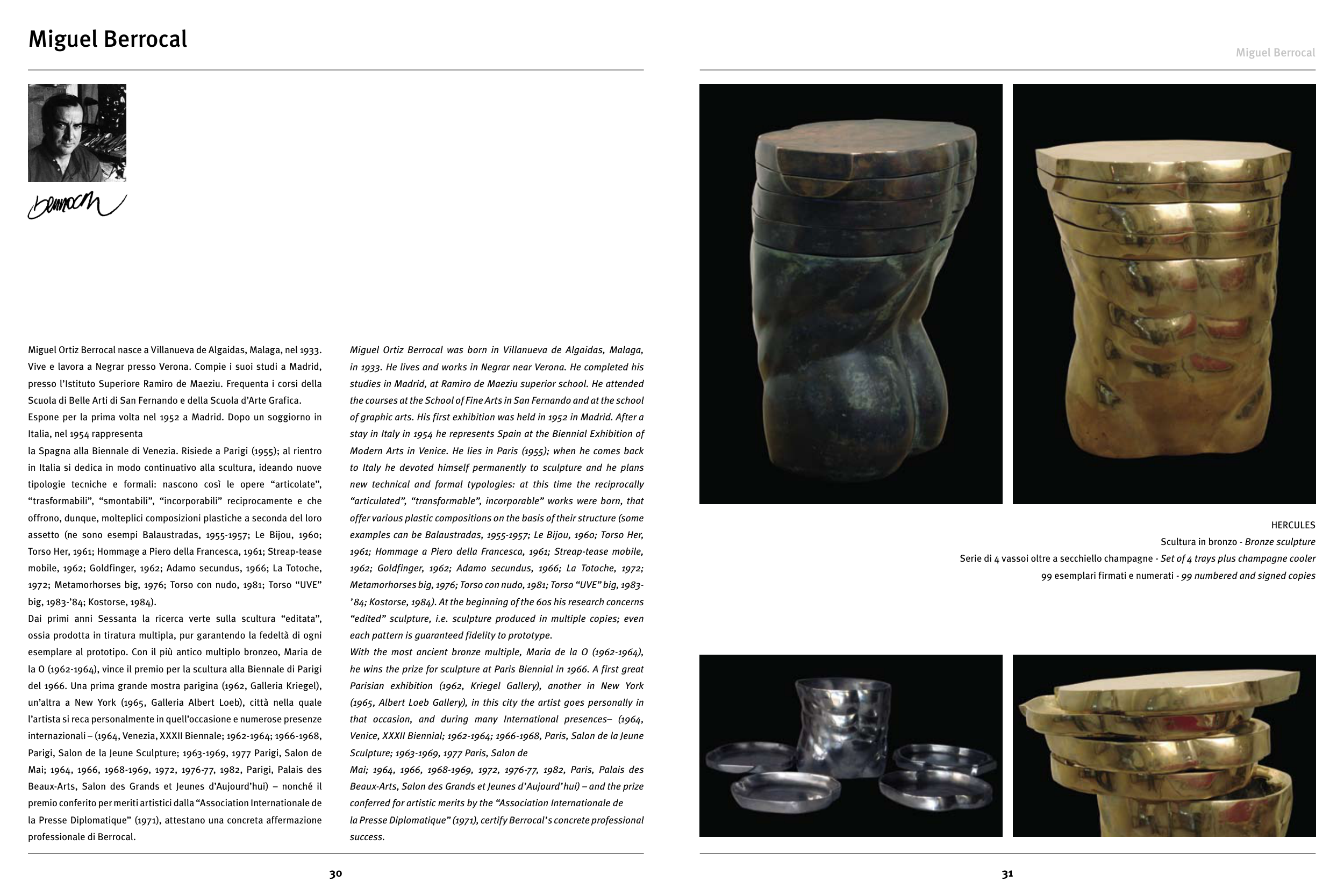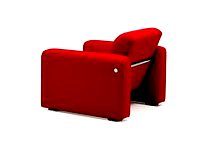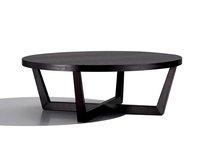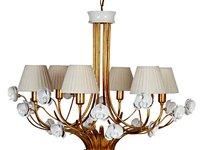Miguel Berrocal
Miguel Ortiz Berrocal nasce a Villanueva de Algaidas, Malaga, nel 1933.
Vive e lavora a Negrar presso Verona. Compie i suoi studi a Madrid,
presso l’Istituto Superiore Ramiro de Maeziu. Frequenta i corsi della
Scuola di Belle Arti di San Fernando e della Scuola d’Arte Grafica.
Espone per la prima volta nel 1952 a Madrid. Dopo un soggiorno in
Italia, nel 1954 rappresenta
la Spagna alla Biennale di Venezia. Risiede a Parigi (1955); al rientro
in Italia si dedica in modo continuativo alla scultura, ideando nuove
tipologie tecniche e formali: nascono così le opere “articolate”,
“trasformabili”, “smontabili”, “incorporabili” reciprocamente e che
offrono, dunque, molteplici composizioni plastiche a seconda del loro
assetto (ne sono esempi Balaustradas, 1955-1957; Le Bijou, 1960;
Torso Her, 1961; Hommage a Piero della Francesca, 1961; Streap-tease
mobile, 1962; Goldfinger, 1962; Adamo secundus, 1966; La Totoche,
1972; Metamorhorses big, 1976; Torso con nudo, 1981; Torso “UVE”
big, 1983-’84; Kostorse, 1984).
Dai primi anni Sessanta la ricerca verte sulla scultura “editata”,
ossia prodotta in tiratura multipla, pur garantendo la fedeltà di ogni
esemplare al prototipo. Con il più antico multiplo bronzeo, Maria de
la O (1962-1964), vince il premio per la scultura alla Biennale di Parigi
del 1966. Una prima grande mostra parigina (1962, Galleria Kriegel),
un’altra a New York (1965, Galleria Albert Loeb), città nella quale
l’artista si reca personalmente in quell’occasione e numerose presenze
internazionali – (1964, Venezia, XXXII Biennale; 1962-1964; 1966-1968,
Parigi, Salon de la Jeune Sculpture; 1963-1969, 1977 Parigi, Salon de
Mai; 1964, 1966, 1968-1969, 1972, 1976-77, 1982, Parigi, Palais des
Beaux-Arts, Salon des Grands et Jeunes d’Aujourd’hui) – nonché il
premio conferito per meriti artistici dalla “Association Internationale de
la Presse Diplomatique” (1971), attestano una concreta affermazione
professionale di Berrocal.
Miguel Ortiz Berrocal was born in Villanueva de Algaidas, Malaga,
in 1933. He lives and works in Negrar near Verona. He completed his
studies in Madrid, at Ramiro de Maeziu superior school. He attended
the courses at the School of Fine Arts in San Fernando and at the school
of graphic arts. His first exhibition was held in 1952 in Madrid. After a
stay in Italy in 1954 he represents Spain at the Biennial Exhibition of
Modern Arts in Venice. He lies in Paris (1955); when he comes back
to Italy he devoted himself permanently to sculpture and he plans
new technical and formal typologies: at this time the reciprocally
“articulated”, “transformable”, incorporable” works were born, that
offer various plastic compositions on the basis of their structure (some
examples can be Balaustradas, 1955-1957; Le Bijou, 1960; Torso Her,
1961; Hommage a Piero della Francesca, 1961; Streap-tease mobile,
1962; Goldfinger, 1962; Adamo secundus, 1966; La Totoche, 1972;
Metamorhorses big, 1976; Torso con nudo, 1981; Torso “UVE” big, 1983-
’84; Kostorse, 1984). At the beginning of the 60s his research concerns
“edited” sculpture, i.e. sculpture produced in multiple copies; even
each pattern is guaranteed fidelity to prototype.
With the most ancient bronze multiple, Maria de la O (1962-1964),
he wins the prize for sculpture at Paris Biennial in 1966. A first great
Parisian exhibition (1962, Kriegel Gallery), another in New York
(1965, Albert Loeb Gallery), in this city the artist goes personally in
that occasion, and during many International presences– (1964,
Venice, XXXII Biennial; 1962-1964; 1966-1968, Paris, Salon de la Jeune
Sculpture; 1963-1969, 1977 Paris, Salon de
Mai; 1964, 1966, 1968-1969, 1972, 1976-77, 1982, Paris, Palais des
Beaux-Arts, Salon des Grands et Jeunes d’Aujourd’hui) – and the prize
conferred for artistic merits by the “Association Internationale de
la Presse Diplomatique” (1971), certify Berrocal’s concrete professional
success.
Miguel Berrocal
HERCULES
Scultura in bronzo - Bronze sculpture
Serie di 4 vassoi oltre a secchiello champagne - Set of 4 trays plus champagne cooler
99 esemplari firmati e numerati - 99 numbered and signed copies
30
31





